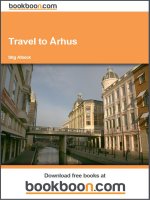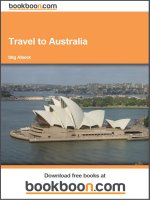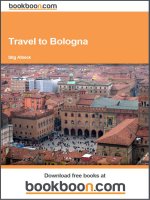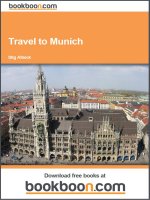Travel to Montréal pot
Bạn đang xem bản rút gọn của tài liệu. Xem và tải ngay bản đầy đủ của tài liệu tại đây (3.31 MB, 36 trang )
Download free ebooks at bookboon.com
Montréal
2
Kapiteloverskrift ONLIBRI
Download free ebooks at bookboon.com
Montréal
© 2008 Stig Albeck & Ventus Publishing ApS
Translation: Annemette Jensen
All rights and copyright relating to the content of this
book are the property of Ventus Publishing ApS, and/or its
suppliers. Content from ths book, may not be reproduced
in any shape or form without prior written permission from
Ventus Publishing ApS.
Quoting this book is allowed when clear references are made,
in relation to reviews are allowed.
ISBN 978-87-7061-317-0
1st edition
Pictures and illustrations in this book are reproduced according
to agreement with the following copyright owners
Tourisme Montréal, Casino de Montréal, Stéphan Poulin,
Commission canadienne du tourisme, Pierre St-Jacques, Louis-
Michel Major, Gorm Albeck, Stanley Park, Stig Albeck,
The stated prices and opening hours are indicative and may
have been subject to change after this book was published.
Download free ebooks at bookboon.com
Montréal
4
Contents
Download free ebooks at bookboon.com
Montréal
5
Montréal
www.tourisme-Montréal.org
tréal.qc.ca
Historical outline
Throughout thousands of years there have been
settlements in the Montréal area. The Indian tribes,
Alqonquin, Huron, and Iroguois, were
representatives here. The first Europeans arriving
to Canada, were Scandinavian Vikings – and the
very first person, thought to have arrived at what
is currently referred to as Montréal, is Jacques
Cartier. He arrived at the Indian village, Hochelega,
in 1535. The first visits, however, did not result in
a permanent settlement from the French.
In the beginning of the 1600s, Samuel de
Champlain decided to establish a trade station by
Port Royal on the Montréal Island. Trade was
mainly centered around the area’s many animal
furs.
A few years later, in 1639, the first truly European
development began. Jérôme le Royer settled here,
and in 1642 the missionaries, Paul Chomedey de
Maisonneuve and Jeanne Mance, followed with
the establishment of the mission, Ville Marie.
Ville Marie quickly became the centre of fur trade,
the Catholic Church, and of the expansion of the
French colony New France. The European
settlement did not happen peacefully, however.
The Iroqois Indians continuously carried out
attacks against the French, until a peace agreement
was signed in 1701.
The development of the city spread fast during the
first half of the 1700s, and the English interest in
the French territory was growing stronger with
time. After an attack and siege, Pierre de Cavagnal,
the Marchion of Vaudreuil, surrendered the city to
the English troops led by Jeffrey Amherst. This
action officially ended the French rule of Montréal,
which the city, by now, was known as. Three years
later France was forced to cede all of New France
to England.
The British development of Montréal was made
difficult in the beginning due to a huge fire taking
place in 1765. About a fourth of the city burnt
down. A reconstruction occurred and the city
really began to blossom with a predominantly
British immigration.
During this time, the fur trade also grew to new
heights bringing with it an economical gain for the
city. The local North West Company was founded
due to this occasion and competed against the,
otherwise dominant, Canadian Hudson’s Bay
Company.
The continued development of Montréal as a
regional centre gained strength in the beginning of
the 1800s. The original French plan with a system
of channels as a way of transportation from the
inner Canada to Montréal was implemented, and
in 1825 the important, for transportation, Canal du
Lachine was completed. The channel enabled
faster and larger transports directly to the
Montréal harbour, where goods were discharged
on ships crossing the Atlantic.
Montréal gained the status of a larger city in 1832,
and in the time period of 1844-1848, the city
functioned as the capital for the united Canadian
province. This attracted more British to the city,
which by now was bilingual. The British founded
McGill University and wealthy families began the
extension of the area around Mont Royal.
In the middle of the 1800s, 60,000 people lived in
Montréal, and it was the larges city in the British
North America. In addition, the city was by far the
financial and cultural centre. Rue Saint Jacques
became the English answer to the American Wall
Montréal
Download free ebooks at bookboon.com
Montréal
6
Street, and, amongst other, the great Canadian
railway companies were founded in the city.
In 1883, and again in 1918, Montréal was united
with surrounding city areas, and this furthered the
French majority of the city, which through the
1900s became more and more dominating in the
lead politics.
After a crisis following the financial crash in 1929,
and the subsequent North American depression, a
certain development took place in the mid 1930s.
Skyscrapers were erected, and many newcomers
arrived. Around the 1950s the population had
grown to over one million, and the city was still
progressing by leaps and bounds. Plans were made
for the establishment of a metro, the underground
city and new harbour and docking area.
Within a decade, Montréal became the setting for a
sizeable media interest. In 1967 the city hosted the
World Exhibition and in 1976 it held the Olympic
Games.
The last few decades of the 1900s showed a
tremendous growth period for the high tech
industry of Montréal. The telecom sector and
pharmaceutical industry are but a few examples
from this business area, which has been a player in
setting the foundation for the modern Montréal of
today.
The latest decades of positive development among
the French culture and the usage of the French
language in Québec has contributed to a certain
amount of abandonment of English speaking
Canadians, to among other, Toronto. Today the
French culture is therefore the most prominent
culture in the city.
Montréal
Download free ebooks at bookboon.com
Montréal
7
Tour 1: Montréal
1. Parc du Mont-Royal
Camillien-Houde/Chemin Remembrance
www.lemontroyal.qc.ca
Metro: Mont-Royal
The Mont-Royal Mountain is practically located in
the middle of Montréal, and with 234 meters to
the peak it provides a beautiful view, not least
from the place chalet, where one may see the city
centre and the St. Lawrence River.
The park opened in 1876. It is designed from the
skecthes of Frederick Law Olmsted, who also
masterminded the New York Central Park. There
are many lovely pathways in the park, and in the
winter, the area is very suitable for cross-country
skiing.
A 30 meter high cross stands tall in the park. It
was constructed in 1924 in memory of the
Maissoneuve Cross from 1643.
2. Musée McCord d’histoire
Canadienne
Rue Sherbrooke Ouest 690
www.mccord-museum.qc.ca
Metro: McGill
This historical museum is among the first in
Canada. Countles artifacts from both Québec and
the rest of Canada are displayed here, among other,
the country’s most prestine collection of textiles
and garments. The photo archive of Notman is
also particularly interesting in depicting the history
of parts of the country.
3. Cathédrale Christ Church
Rue Sainte-Catherine Ouest 635
http://Montréal.anglican.org/cathedral
Metro: McGill
The Christ Church Cathedral is a good example of
neo-gothic architecture. The church is Anglican
and built in 1857-1859. Today, one will find an
underground shopping centre beneath the church,
and in sharp contrast to the church, high rise
housing are next to it, which provides for an
interesting urban space.
4. Musée d’Art Comtemporain
Rue Sainte-Catherine Ouest 185
www.macm.com
Metro: Place-des-Arts
The Museum is the only museum in Canada,
which exclusively exhibits modern art. Here is a
unique opportunity to explore the modern art
from both Quebec and Canada, as well as from
Tour 1: Montréal
Download free ebooks at bookboon.com
Please click the advert
Montréal
8
other regions of the world. The museum usually
arranges several exciting activities in addition to
the exhibition.
5. Quartier Chinois/Chinatown
Boulevard Saint-Laurent/Rue de La
Gauchetière
Metro: Place-d’Armes
The Chinatown of Montréal originates from the
1860s, where Chinese immigrants arrived to work
in mines and railroad construction. Today, the
Chinese culture still blooms in the rail roads of the
neighbourhood, and holidays and festivals are
celebrated as they are in China. The streets are
relatively commercially oriented, but notice the
details, for instance, the imperially imitated gate
entrance.
6. Basilique Notre-Dame
Rue Notre-Dame Ouest 110
www.basiliquenddm.org
Metro: Place-d’Armes
The Notre Dame of Montréal is an impressive
cathedral erected in neo-gothic style during the
time 1824-1829. The edifice is famous for its very
beautiful interior containing fantastic wood
sculptures and paintings, as well as many types of
gilding. The cathedral is also referred to as the
Blue Church due to the use of this very colour in
the church room.
Tour 1: Montréal
Download free ebooks at bookboon.com
Montréal
9
The sculptures and beautiful glass mosaics of the
Notre Dame portray both biblical stories and
scenes from the parish’s highlights throughout the
last 350 years. The cathedral is amongst the largest
in North America, and seats 4,000 people.
7. Vieux Séminaire Saint-Sulpice
Rue Notre-Dame Ouest 130
Metro: Place-d’Armes
This is the oldest building in Montréal,
constructed in 1684-1687 in a style representing
the official New France. The clock of the building
dates back to 1701 and is, thus, the oldest of its
kind in all of North America.
8. Théâtre Centaur
Rue Saint-François-Xavier 453
www.centaurtheatre.com
Metro: Place-d’Armes
The Centaur Theatre in Montréal is the leading
English speaking theatre. It was established in
1969. The theatre building is especially interesting
as it was originally constructed according to stately
style in 1903 as the city’s stock exchange.
9. Hôtel de Ville
Rue Notre-Dame Est 275
Metro: Champ-de-Mars
The City Hall of Montréal, Hotel de Ville, is one
of the city’s characteristic old buildings. The
building is constructed by Alexander Cowper
Hutchison in 1872-1878, and it went through
renovation following an extensive fire in 1922.
It was from the City Hall balcony that the French
President, Charles de Gaulle, held his famous
speech in 1967 containing the statement “Vive le
Québec Libre” (Long live a free Québec). One
may view the lobby and, if interested, one can gain
further knowledge of the interior and history of
the City Hall by taking a guided tour. Outside, the
illumination of the building can be enjoyed in the
evening.
10. Marché Bonsecours
Rue Saint-Paul Est 350
www.marchebonsecours.qc.ca
Metro: Champ-de-Mars
The impressive market building, Bonsecours, was
built in 1844-1847 as the city’s agricultural market.
It kept this function until 1963, and during the
same time it served as the city’s City Hall and
Concert Hall for a while. Today, the building is yet
again designed for the purpose of markets - now,
much lively, containing a fair amount of shops
primarily for artists.
Marché Bonsecours is constructed in Neo-
Classical style with traces from Ancient Greece.
The cast iron pillars have been shipped here from
England, and they are but one example of, the city
wanted the building to function as the land mark
for the greatness and development of Montréal.
On the construction site itself was the former
mansion of François Bigot’, who was the last
French administrator of New France. He resided
here during 1749-1760. The Théâtre Royal has also
resided here for about 20 years, and its ruins still
lie beneath the Marché Bonsecours.
11. Chapelle Notre-Dame-de-
Bon-Secours
Rue Saint-Paul Est 400
www.marguerite-bourgeoys.com
Metro: Champ-de-Mars
Tour 1: Montréal
Download free ebooks at bookboon.com
Montréal
10
This charming little church was built in 1771-1773.
Both the façade and the back of the church
building are results of later extensions.
Originally, the first church was founded here in
1655 by the initiativ of Marquerite Bourgeoys, and
in 1675 the city’s first stone church was
constructed on the site.
It burned down, however, in 1754, but due to
disputes with England, the development of a new
church was not begun immediately. One can go up
the tower and, from it, see a splendid view of the
old parts of Montréal and the old harbour.
Tour 1: Montréal
Download free ebooks at bookboon.com
Please click the advert
Montréal
11
Tour 2: Montréal
12. Jardin Botanique
Rue Sherbrooke Est 4101
www.ville.Montréal.qc.ca/jardin
Metro: Pie-IX
The botanical garden in Montréal is regarded as
one of the leading botanical gardens in the world.
There are more than 22,000 plants in the 30
gardens and 10 greenhouses. Among the beautiful
grounds there are also a Chinese and Japanese
garden.
13. Tour de Montréal &
Parc Olympique
Avenue Pierre de Coubertin 4141
www.rio.gouv.qc.ca
Metro: Viau
Montréal’s Olympic Park, with one of the city’s
landmarks, the tower of the complex, was erected
for holding the Olympic Games in 1976. The
architect of the tower is French Roger Tailibert,
and from the top of his work of art there is a
stunning view of great parts of Montréal. The
tower, with its 175 meters, is the tallest leaning
tower in the world, with an inclination of 45
degrees.
Tour 2: Montréal
© Deloitte & Touche LLP and affiliated entities.
360°
thinking
.
Discover the truth at www.deloitte.ca/careers
© Deloitte & Touche LLP and affiliated entities.
360°
thinking
.
Discover the truth at www.deloitte.ca/careers
© Deloitte & Touche LLP and affiliated entities.
360°
thinking
.
Discover the truth at www.deloitte.ca/careers
© Deloitte & Touche LLP and affiliated entities.
360°
thinking
.
Discover the truth at www.deloitte.ca/careers
Download free ebooks at bookboon.com
Montréal
12
In addition to the tower, the entire complex is
comprised of the centre stadium, a sports centre,
and other buildings, such as a former velodrom.
The gracious stadium holds 55,000 spectators
below its round and lightweight appearing
concrete structure. Guided tours are available on
the grounds.
14. Immeuble du Centre de
commerce mondial de
Montréal/World Trade Centre
Rue du Square-Victoria 747
Metro: Square-Victoria
This office complex was finished in 1992. It
combines modern architecture with buildings from
the old Montréal, among others, the Nordheimer
building from 1888.
Inside the great atrium, the buildings belonging to
different times do themselves justice, and here,
one will also find a shopping promenade. In
addition to the centre itself, there are some
intriguing sights, such as a piece of the Berlin Wall
and a water fountain statue created by the French
sculptor, Dieudonné-Barthélemy Guibal, in the
beginning of the 1700s. The statue was originally
placed in France.
15. Le Souterrain/
The Underground City
A network of underground pathways, shopping
centres, museum entrances, metro stations,
restaurants, and so forth, exist below great parts of
the centre of Montréal. This way, one can travel
around the city without regards to the cold winters,
common for the area. There are more than 33
kilometres of walkways, and more than 500,000
people pass through the system every day.
16. Centre d’histoire de Montréal
Place d’Youville 335
www.ville.Montréal.qc.ca/chm
Metro: Place-d’Armes
The history of the city, beginning in 1535 is told at
the city museum in Montréal. The museum
building is arranged in one of the city’s former,
and charming, fire stations. The exhibitions are
intriguing and show interesting paintings and
effects from many facets of the great events that
have taken place.
17. Pointe–à-Callière
Place Royale 350
www.pacmuseum.qc.ca
Metro: Place-d’Armes
The Montréal museum for history and archaeology
fascinatingly portrays the city’s history, and, in
addition, the museum is located in the exact spot
where Montréal was founded. Ruins are seen here
from the earliest times of Montréal, as well as a
number of finds, photographs, and so forth.
18. Trips around the harbor/
Bateau-Mouche
Quai Jacques-Cartier
www.bateau-mouche.com
Metro: Champ-de-Mars/Place-d’Armes
Sailing around the harbour, one will experience the
city from a new perspective, and, from the water,
get an entirely different view of the skyscrabers
and landmarks. The trip is especially interesting, as
the boat is the original tourboat from the River
Seine in Paris.
Tour 2: Montréal
Download free ebooks at bookboon.com
Montréal
13
Notice that the harbour roundtrip, due to the
weather, only sails mid May-mid October.
19. Habitat ’67
2600 Avenue Pierre-Dupuy
www.habitat67.com
Metro: Parc Jean-Drapeau
The area, Cité-du-Havre, has been created due to
fillings as a way to protect the Montréal harbour
from, among other, ice. The unique construction,
Habitat ’67, was built on the site for the World
Exhibition in 1967.
Habitat ’67 is a very different building, where the
apartments, are almost stabled randomply as
singular building blocks on top each other. The
architect of the building is Moshe Safdie, who was
only 23 years old in 1967.
20. Île Sainte-Hélène
Metro: Parc Jean-Drapeau
This island is layed out as a park- and activity area,
and there are many things to do here. The
amusement park, La Ronde, and the Biospère to
mention a few. Taking a walk, one can experience
the many sculptures arranged on the island.
21. Île Notre-Dame
Metro: Parc Jean-Drapeau
The Notre-Dame Lake is a lovely recreational area,
where one is close to both the St. Lawrence River
and green areas rare in their beauty.
The garden, Jardins des Floralies, is a beautiful
flower park, originally established for the World
Exhibition in 1967, and located at the center of the
island.
Along almost the entire lenght of the island, the
olympic pool is placed, where, continously, many
activities are held. Along the pool and around the
island one can see the racetrack named after the
Canadian Gilles-Villeneuve. Here, Formula 1 and
other motor races are held.
At the center of the island, quite a few channels
have been constructed, which one may enjoy a trip
on, and it also includes a sand beach.
22. Casino de Montréal
Casino Avenue du Casino 1
www.casino-de-Montréal.com
Metro: Jean-Drapeau
At the World Exhibition in 1967, a number of
pavilions were built from countries and regions
around the world, and in the pavilions for France
and for Québec one will find the great and newly
remodelled casino in Montréal.
In addition to numerous one-armed bandits and
gambling tables, there is also a cabaret seating 500
people, more restaurants, and other entertainment
offers.
Tour 2: Montréal
Download free ebooks at bookboon.com
Please click the advert
Montréal
14
23. Canal du Lachine
www.pc.gc.ca/lachinecanal
The Lachine channel is Montréal’s historical
waterway due West from the old harbour. The
channel was constructed in 1825 and saved boats
from long trips up the river. The channel is 14.5
kilometres long and connects the harbour with the
Lac Saint-Louis Lake.
The layout of the channel was an important part
of the 1800s endeavours to create ways of
transport from the Atlantic to the central parts of
Canada. Following this water passage, railways and
roads were later added.
Canal du Lachine was closed for traffic in 1970,
when a larger channel was constructed by the St.
Lawrence River. The channel was reopened in
2002 for tour boats, and the navigation includes
cosy city areas and beautiful nature.
Along the channel banks one will find lovely bike
paths with opportunity for many interesting stops
along the way.
Tour 2: Montréal
Increase your impact with MSM Executive Education
For more information, visit www.msm.nl or contact us at +31 43 38 70 808
or via
the globally networked management school
For more information, visit www.msm.nl or contact us at +31 43 38 70 808 or via
For almost 60 years Maastricht School of Management has been enhancing the management capacity
of professionals and organizations around the world through state-of-the-art management education.
Our broad range of Open Enrollment Executive Programs offers you a unique interactive, stimulating and
multicultural learning experience.
Be prepared for tomorrow’s management challenges and apply today.
Executive Education-170x115-B2.indd 1 18-08-11 15:13
Download free ebooks at bookboon.com
Please click the advert
Montréal
15
Tour 2: Montréal
Get “Bookboon’s Free Media Advice”
See the light!
The sooner you realize we are right,
the sooner your life will get better!
A bit over the top? Yes we know!
We are just that sure that we can make your
media activities more effective.
Download free ebooks at bookboon.com
Montréal
16
Day tours from
Montréal
24. Les Laurentides
50 km North
www.laurentides.com
The Laurentides area north of Montréal is known
for its beautiful and mountainous nature, which is
worth a visit both in the summer and winter.
In the summer, the mountains are inviting for
hikes, where one gets all the way out in the
wilderness. A lovely spot is Parc du Mont-
Tremblant, which is a park around the mountain,
Mont-Tremblant. The mountain is the highest in
the area reaching 935 meters, and the park is a
gathering place for many activities, for instance,
canoeing, biking, and fishing.
In the winter, the area is a great ski resort with all
kinds of winter activities. At the Mont St Sauveur
Mountain, one can ski at night. Cabins are also
available for rent for long visits here.
Day Tours from Montréal
Download free ebooks at bookboon.com
Montréal
17
With children in Montréal
Exporail/Canadian Railway Museum
(Rue Saint-Pierre 110):
www.exporail.org
Zoo de Granby (Rue Saint-Hubert 525):
www.zoodegranby.com
Planétarium de Montréal (Rue Saint-Jacques 1000):
www.planetarium.Montréal.qc.ca
Montréal Aquaparc (Île-Sainte-Hélène)
La Ronde (Île-Sainte-Hélène)
Shopping in Montréal
Rue Sherbrooke, Rue Ste-Catherine, Rue Saint
Hubert, Chinatown
Centre Eaton de Montréal
(705 Rue Ste-Catherine W):
www.centreeatondeMontréal.com
Complexe Desjardins (150 Rue Ste-Catherine W):
www.complexedesjardins.com
Le Faubourg (1616 Rue Ste-Catherine W):
www.lefaubourg.com
Marché Bonsecours (Rue Saint-Paul Est 350):
www.marchebonsecours.qc.ca
Place Montréal Trust
(1500 Avenue
McGill College):
www.placeMontréaltrust.com
Place Ville Marie (Place Ville Marie):
www.placevillemarie.com
Public transportation in Montréal
Montréal City transportation:
www.stm.info
Montréal Metro:
www.metrodeMontréal.com
Montréals Airport:
www.admtl.com
Canada’s Railways:
www.viarail.com
Children / Shopping / Transportation
Download free ebooks at bookboon.com
Please click the advert
Montréal
18
Metro Map
Metro Map
GO T -THE-ENERGY-TO-LEAD.COM
We believe that energy suppliers should be renewable, too. We are therefore looking for enthusiastic
new colleagues with plenty of ideas who want to join RWE in changing the world. Visit us online to find
out what we are offering and how we are working together to ensure the energy of the future.
Download free ebooks at bookboon.com
Montréal
19
Facts about Canada
Politics
Official name Canada
Capital Ottawa
Government type Constitutional monarchy
Head of state Queen Elizabeth II
Head of government Prime Minister Stephen Harper
National holiday July 1
Independence July 1, 1867, from Great Britain
Primary Religion Christianity
Language English
Area 9.984.670 km²
Population (2007) 33.027.000
Borders on
North Beaufort Sea, Ice Sea
South The U.S.
East The Atlantic Ocean, St. Lawrence Bay, Labrador Sea, Davis
Strait, Baffin Bay
West The U.S., The Pacific Ocean
Facts about Canada
Download free ebooks at bookboon.com
Please click the advert
Montréal
20
Highest Mountains
Mount Logan 5.959 meters
Mount St. Elias 5.488 meters
Mount Lucania 5.226 meters
King Peak 5.173 meters
Mount Steel e 5.067 meters
Mount Wood 4.838 meters
Mount Vancouver 4.785 meters
Mount Slaggard 4.742 meters
Mount MacAuley 4.700 meters
Fairweather Mountain 4.663 meters
Facts about Canada
Contact us to hear more
Who is your target group?
And how can we reach them?
At Bookboon, you can segment the exact right
audience for your advertising campaign.
Our eBooks offer in-book advertising spot to reach
the right candidate.
Download free ebooks at bookboon.com
Montréal
21
Largest islands
Baffin Island 507 451 km²
Victoria Island 217 291 km²
Ellesmere Island 196 236 km²
Newfoundland 108 860 km²
Banks Island 70 028 km²
Devon Island 55 247 km²
Axel Heiberg Island 43 178 km²
Melville Island 42 149 km²
Southampton Island 41 214 km²
Prince of Wales Island 33 339 km²
Vancouver Island 31 285 km²
Largest lakes
Lake Huron* 36 000 km²
Great Bear Lake 30 764 km²
Lake Superior* 28 700 km²
Great Slave Lake 27 048 km²
Lake Winnipeg 23 760 km²
Lake Erie* 12 800 km²
Lake Ontario* 10 300 km²
Lake Athabasca 7 849 km²
Smallwood Reservoir 6 460 km²
Raindeer Lake 5 658 km²
*is partly U.S. territory
Facts about Canada
Download free ebooks at bookboon.com
Montréal
22
Longest rivers
Mackenzie River 4 241 km
Yukon River 3 185 km
St. Lawrence River 3 058 km
Nelson River 2 575 km
Columbia River 2 000 km
South Saskatchewan River 1 939 km
Peace River 1 923 km
Churchill River 1 609 km
Saskatchewan River 1 392 km
Fraser River 1 370 km
Largest cities (2006)
Toronto 5 113 000
Montréal 3 636 000
Vancouver 2 117 000
Ottawa-Gatineau 1 131 000
Calgary 1 079 000
Edmonton 1 035 000
Québec 716 000
Winnipeg 695 000
Hamilton 693 000
London 458 000
Facts about Canada
Download free ebooks at bookboon.com
Please click the advert
Montréal
23
Provinces and territories
Alberta 661 848 km²
British Columbia 944 735 km²
Manitoba 647 797 km²
New Brunswick 72 908 km²
Newfoundland and Labrador 405 212 km²
Northwest Territories 1 346 106 km²
Nova Scotia 55 284 km²
Nunavut 2 093 190 km²
Ontario 1 076 395 km²
Prince Edward Island 5 660 km²
Québec 1 542 056 km²
Saskatchewan 651 036 km²
Yukon Territory 482 443 km²
Facts about Canada
THE BEST MASTER
IN THE NETHERLANDS
Download free ebooks at bookboon.com
Montréal
24
Administrative divisions
Province/territory Capital
Alberta Edmonton
British Columbia Victoria
Manitoba Winnipeg
New Brunswick Fredericton
Newfoundland and Labrador St. John’s
Northwest Territories Yellowknife
Nova Scotia Halifax
Nunavut Iqaluit
Ontario Toronto
Prince Edward Island Charlottetown
Québec Québec
Saskatchewan Regina
Yukon Territory Whitehorse
Head of State since 1763
George III 1763-1820
George IV 1820-1830
William IV 1830-1837
Victoria 1837–1901
Edward VII 1901–1910
George V 1910-1936
Edward VIII 1936-1936
George VI 1936-1952
Elizabeth II 1952-
Prime Ministers since 1945
William Lyon LacKenzie King 1935-1948
Louis St. Laurent 1948-1957
John Diefenbaker 1957-1963
Lester B. Pearson 1963-1968
Pierre Trudeau 1968-1979 och 1980-1984
Joe Clark 1979-1980
Facts about Canada
Download free ebooks at bookboon.com
Montréal
25
John Turner 1984-1984
Brian Mulroney 1984-1993
Kim Campbell 1993-1993
Jean Chrétien 1993-2003
Paul Martin 2003-2006
Stephen Harper 2006-
Holidays and Memorial days*
January 1 New Year’s Day
Date varies Good Friday
Date varies Easter Day
Date varies Easter Monday
July 1 Canada Day
First Monday in September Labour Day
December 25 Christmas Day
December 26 Boxing Day
*also varies depending on the state
Diverse information
Currency Canadian Dollar
Currency symbol CAD
Time zone Newfoundland Standard Time/NST (UTC-3:30)
Atlantic Standard Time/AST (UTC-4)
Eastern Standard Time/EST (UTC-5)
Central Standard Time/CST (UTC-6)
Mountain Standard Time/MST (UTC-7)
Pacific Standard Time/PST (UTC-8)
Yukon Standard Time/YST (UTC-8)
Postal code CDN
Internet domain .ca
Country calling code +1
Facts about Canada









